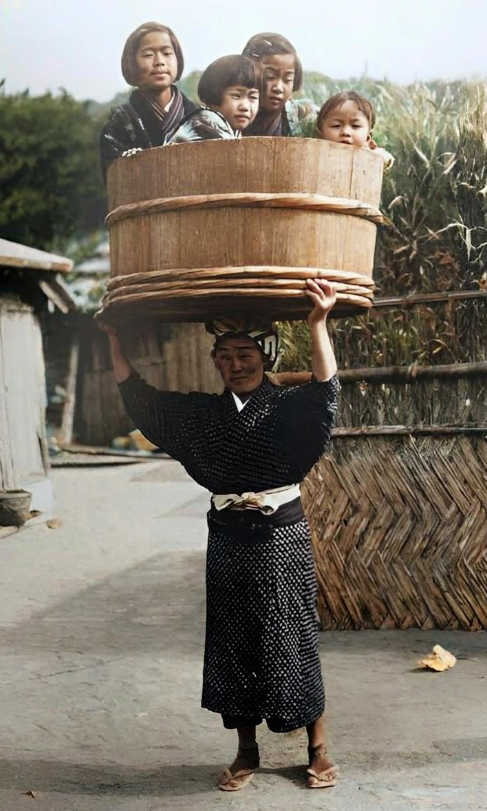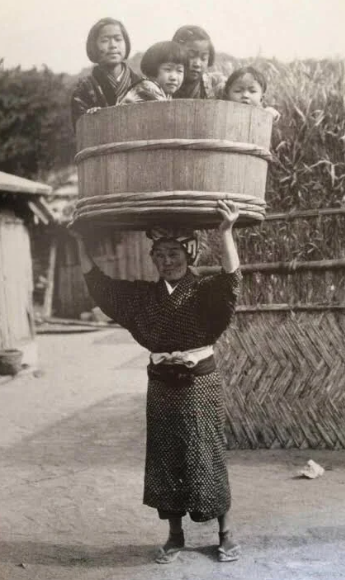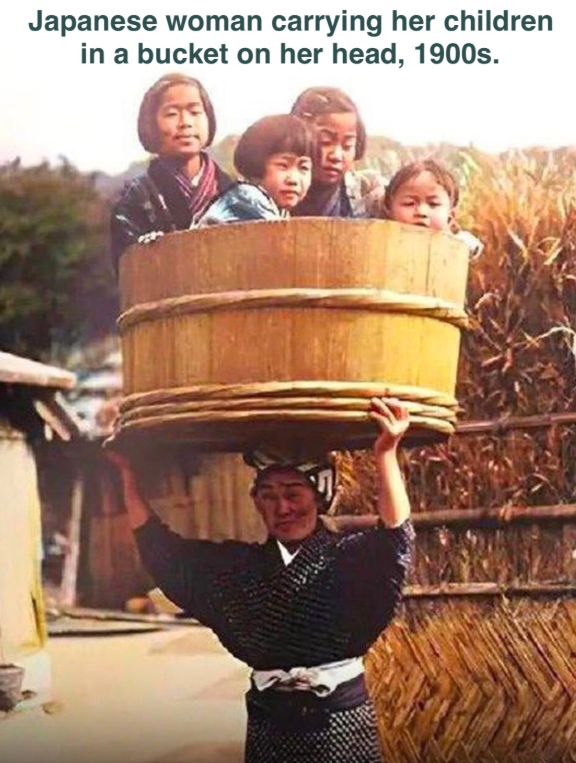The early 20th century in Japan was a time of cultural transition, as traditional ways of life merged with the advent of modernization. A striking image of Woman Carrying Her Children in a Bucket from this era depicts a Japanese woman holding a child in a bucket on her head. Explore with archeology.dulichvn.net This touching snapshot offers a unique insight into the resilience, resourcefulness, and family ties of everyday life in Japan in the 1900s.
A Woman Carrying Her Children in a Bucket Japan in the 1900s
To fully understand the context of this photograph, it’s important to explore the societal landscape of Japan in the early 20th century.

1. Traditional Lifestyles
Agrarian Society: Many Japanese families relied on agriculture for their livelihood, leading to a hardworking, rural way of life.
Daily Struggles: Families often had to be resourceful in balancing work and childcare, as depicted in this image.
Cultural Practices: Traditional attire, hairstyles, and methods of transport defined rural Japan during this era.
2. Urbanization and Modernization
Meiji Restoration Impact: The late 1800s and early 1900s saw Japan rapidly industrialize and adopt Western technologies.
Cultural Fusion: Rural areas maintained traditional practices while cities became hubs of modernity.
Economic Shifts: The blend of old and new created a unique societal structure, influencing how families navigated their daily lives.
See more: Antique wooden combs at Vindolanda: Timeless heritage
3. The Role of Women
Family Caretakers: Women were primarily responsible for domestic duties and childcare, even while contributing to labor outside the home.
Multitasking Necessity: Images like this highlight the multitasking abilities of women, balancing work and family in inventive ways.
Cultural Expectations: Women were often celebrated for their resilience and dedication to family.
The Story Behind the Photograph
The photograph of a Japanese woman carrying her children in a bucket on her head provides a vivid narrative of maternal ingenuity and determination.

1. The Practicality of Buckets
Everyday Tools: Buckets were a common household item in rural Japan, used for transporting water, food, and sometimes even children.
Efficient Transportation: In an era without strollers or modern conveniences, improvisation was key to managing multiple tasks.
Balanced Skill: Carrying a bucket on the head required remarkable balance and strength, showcasing the woman’s physical capability.
2. Depicting Maternal Care
Keeping Children Close: Carrying children in a bucket allowed the mother to keep them safe and near while working.
A Symbol of Love: The image highlights the deep bond and care between mother and children, emphasizing her resourcefulness.
Shared Struggles: This portrayal resonated with many families facing similar challenges in rural areas.
See more: Discovering the Fascinating Crinoid Period A Glimpse into Ancient Marine Life
3. Capturing a Moment in Time
Cultural Documentation: The photograph serves as a historical record of rural Japanese life in the early 1900s.
Everyday Reality: Unlike staged portraits, this candid shot reflects the practicalities of daily life.
Universal Themes: The themes of maternal love and sacrifice transcend time and geography, making the image relatable even today.
The Legacy of the Photograph
This iconic photograph has left a lasting impression, sparking discussions about cultural history, societal roles, and the resilience of women.

1. Historical Significance
Representation of Rural Life: It provides invaluable insight into the lives of ordinary people in early 20th-century Japan.
Preservation of Traditions: The image reminds us of cultural practices that have since evolved or disappeared.
Educational Value: Historians and educators use such photographs to teach about the era’s social and cultural fabric.
2. Women’s Strength and Ingenuity
Timeless Admiration: The woman’s resourcefulness and strength are celebrated as symbols of women’s resilience throughout history.
Highlighting Maternal Roles: The image underscores the multifaceted roles women played, balancing work and family responsibilities.
Empowering Narratives: Stories like these inspire modern audiences by showcasing the enduring strength of women in all circumstances.
3. Cultural Appreciation
Global Fascination: The photograph captures audiences worldwide, offering a glimpse into a culture rich with tradition and innovation.
Tourism and Heritage: It sparks interest in exploring Japan’s rural history, encouraging deeper appreciation of its heritage.
Artistic Inspiration: Artists and writers often draw inspiration from such images to create works that celebrate cultural identity.
Conclusion
The photograph of a Japanese woman carrying her children in a bucket on her head, taken in the 1900s, is a powerful testament to the ingenuity, resilience, and love inherent in family life. It encapsulates the spirit of an era where traditional practices met the challenges of modernization, offering a poignant snapshot of maternal devotion.
As a piece of living history, this image continues to inspire awe and admiration, reminding us of the everyday heroes who shaped the world we live in today. Whether viewed through a historical, cultural, or emotional lens, it remains a timeless symbol of strength and care in the face of life’s challenges.

CÁC TIN KHÁC
Mark Twain & Olivia Langdon: A 36-Year Love Story Filled with Laughter and Devotion
The Tollund Man: A 2,400-Year-Old Mystery Preserved in a Danish Bog
Skara Brae: Scotland’s Hidden Neolithic Village
Porta Nigra: The Hidden Depths of Trier’s Iconic Roman Gate